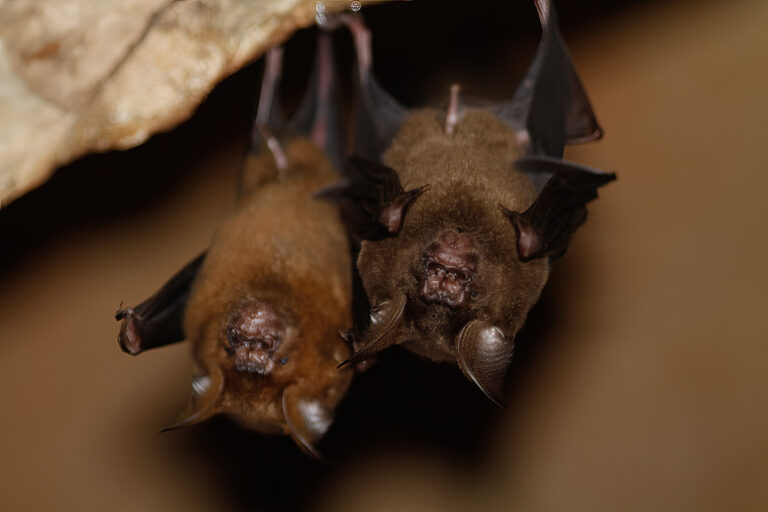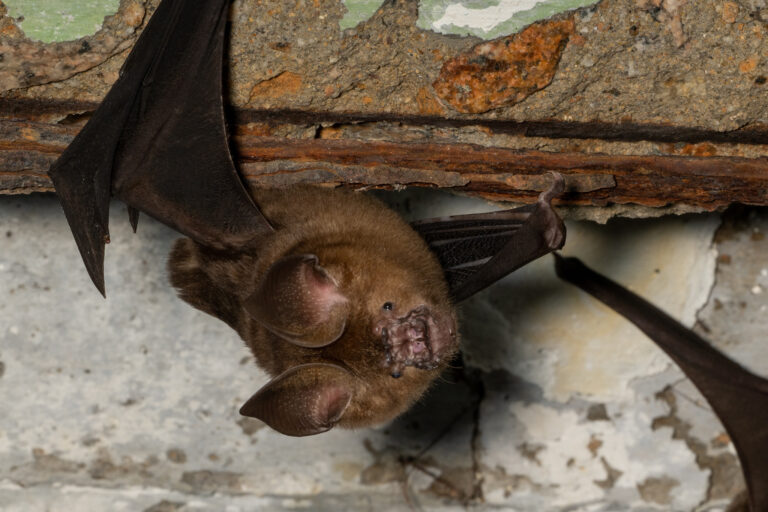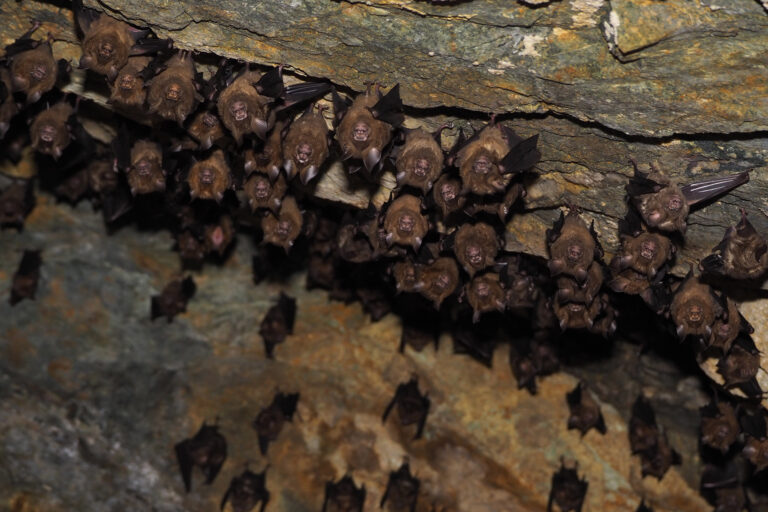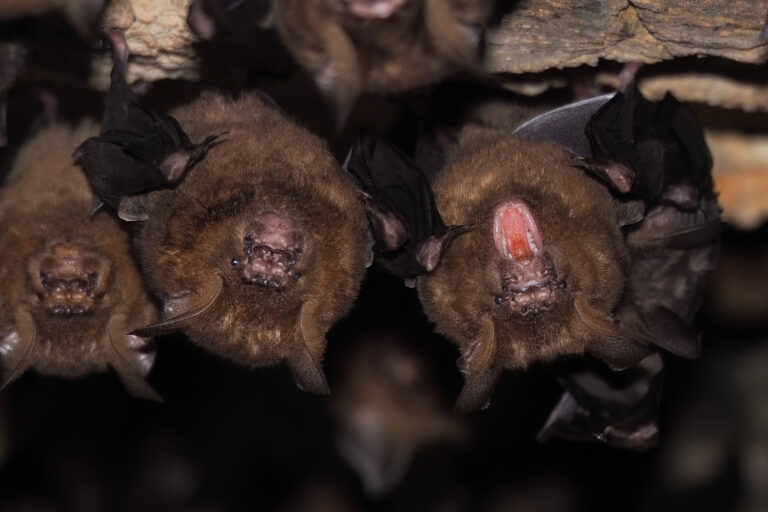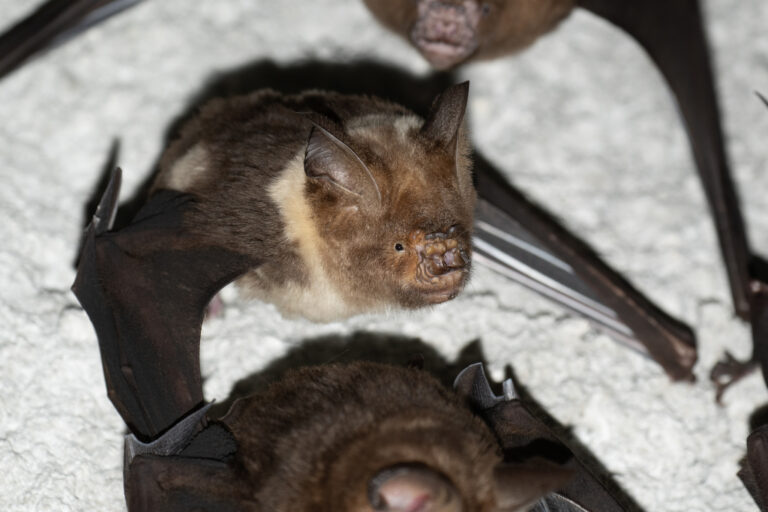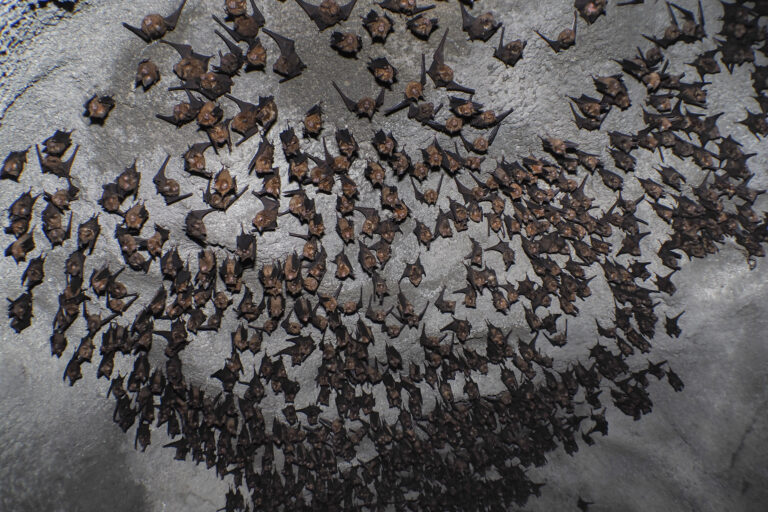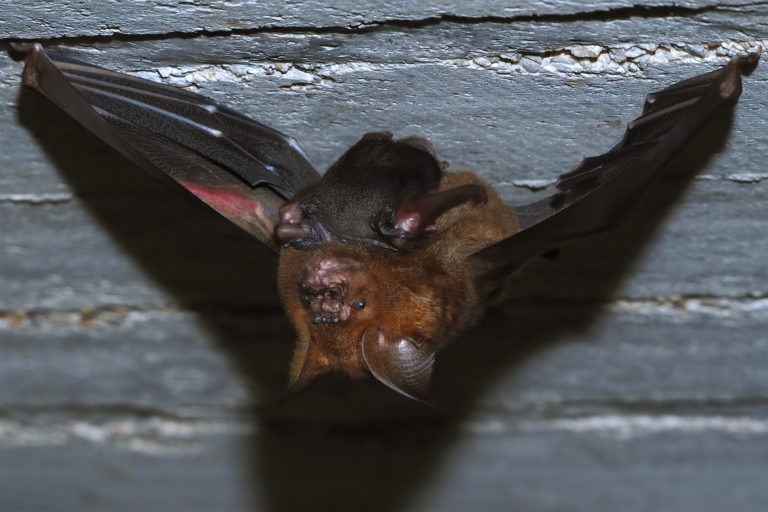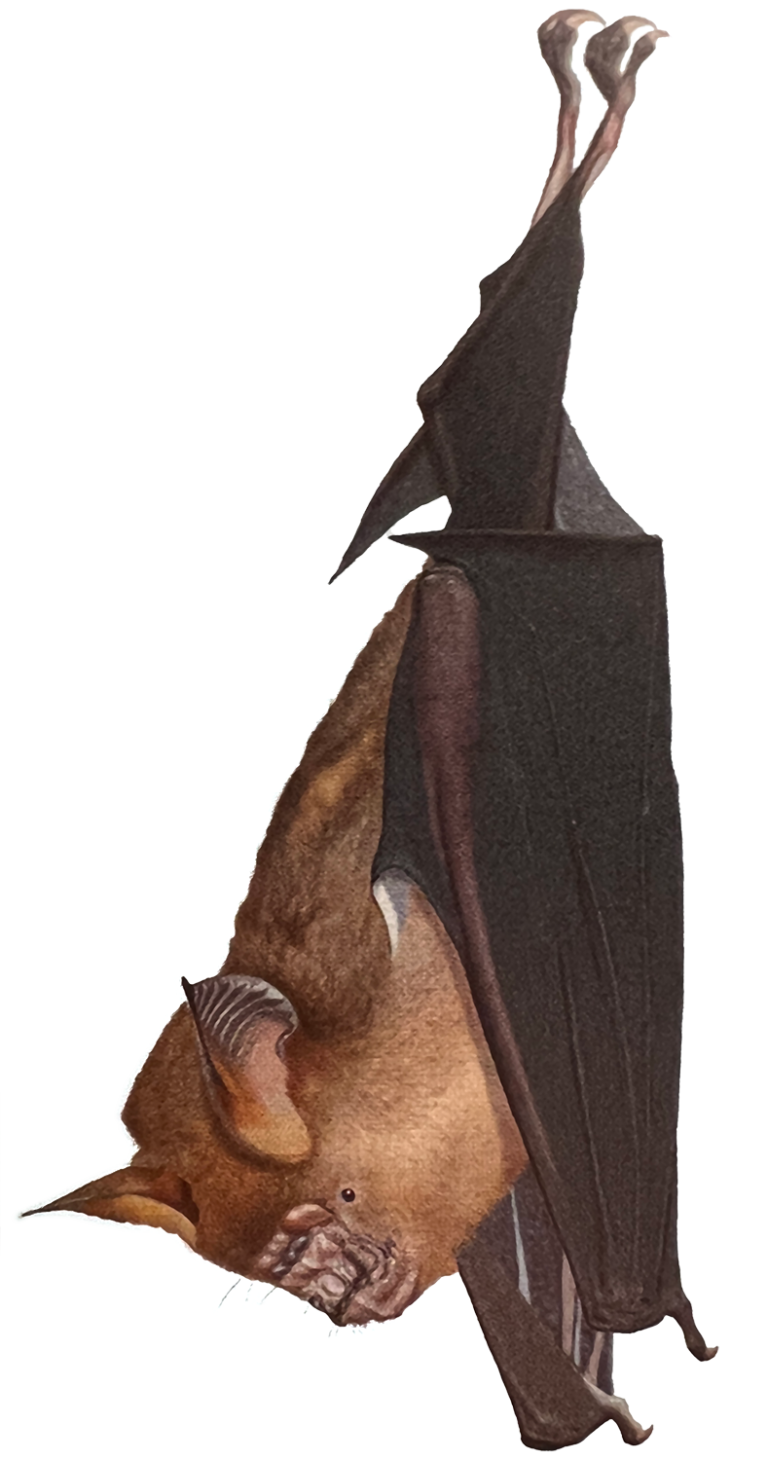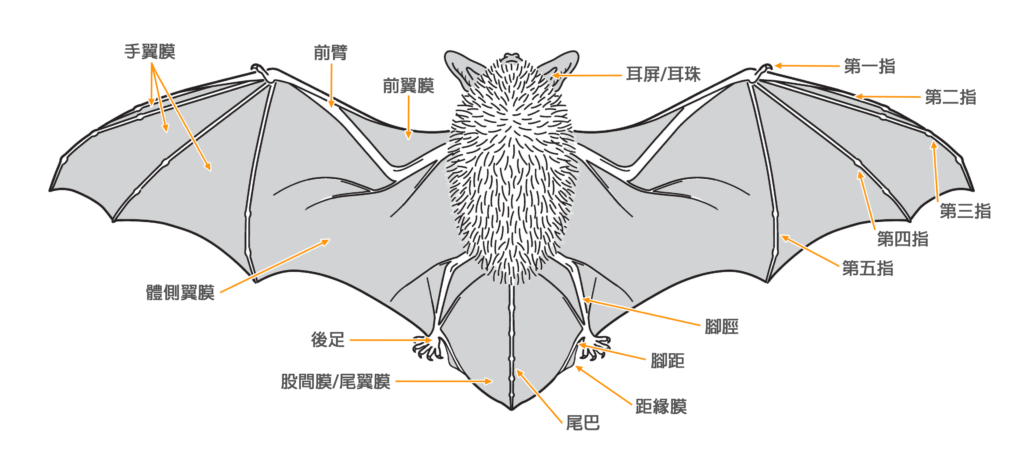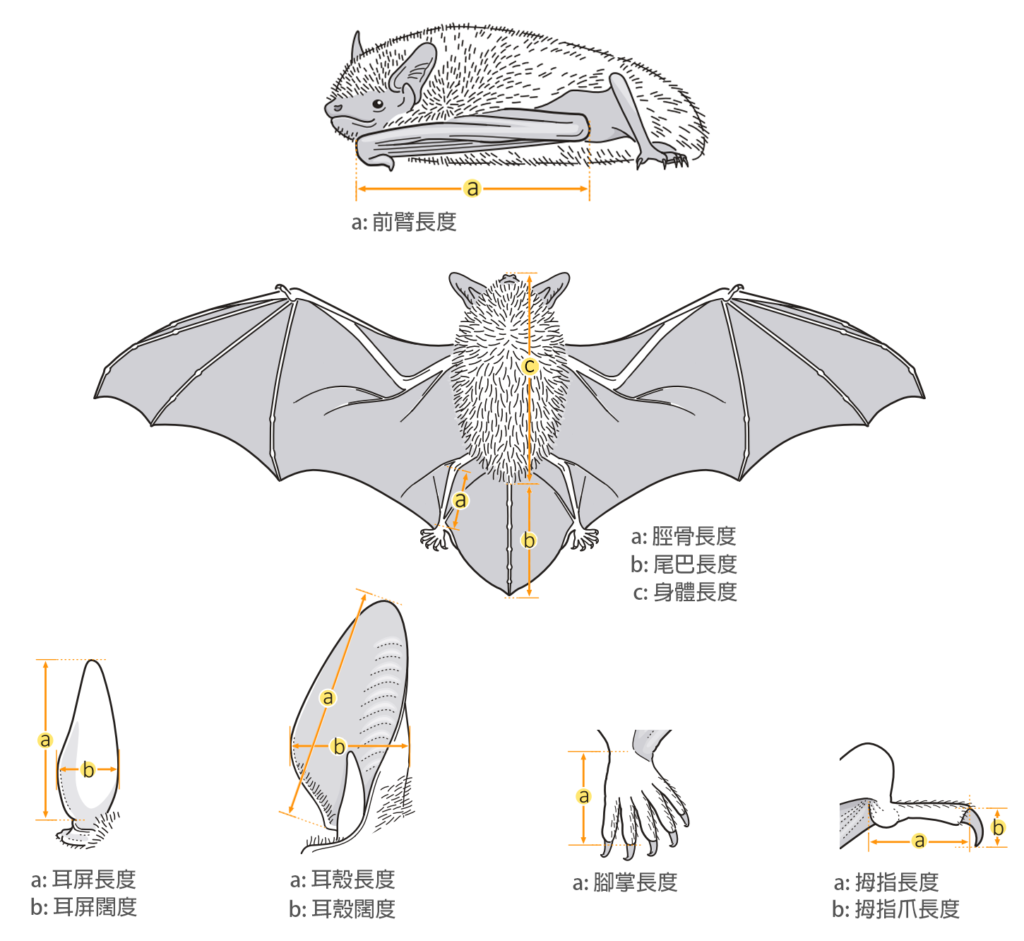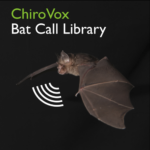分類學
| 科: | 蹄蝠科 (Hipposideridae) |
| 屬: | 蹄蝠屬 (Hipposideros ) |
| 學名: | Hipposideros armiger (Hodgson, 1835) |
| 異名: | Rhinolophus armiger Hodgson, 1835 |
| 本地英文名: | Himalayan Leaf-nosed Bat |
| 其他英文名: | Great Leaf-nosed Bat, Great/Himalayan Roundleaf Bat |
| 本地中文名: | 大蹄蝠 |
| 其他中文名: | 大馬蹄蝠 |
| 分類註釋: | H. armiger 包括4個已知亞種:H. a. armiger (Hodgson, 1835)、H. a. fujianensis (Zhen, 1987)、H. a. terasensis (Kishida, 1924) 及 H. a. traninhensis (Bourret, 1942)。據地理分布,香港的大蹄蝠屬於H. a. armiger。 |
| 外形特徵 | |
| 毛色: | 有兩種色態,棕色及灰棕色;背毛與腹毛顏色相近;頭部毛色相對較深;有時會有毛髮部分白化的個體 |
| 耳朵: | 耳殼闊大,內側具多條橫坑紋,耳端略尖;耳殼及對耳屏均為棕色至深棕色;對耳屏短小並與耳殼相連 |
| 頭部: | 頭顱大;眼睛細小 |
| 鼻葉: | 鼻葉較複雜,分為前中後葉;前葉較闊呈馬蹄狀,兩側各具4片小側葉,最外側的較不明顯;中葉隆起;後葉被2個縱隔分成3個部分,呈三結狀突起 |
| 尾部: | 尾長,未端略微突出股間膜 |
| 其他: | 額頭具橫狀開口的前額囊,中間有一束黑毛;雌雄均有,雌蝠的前額囊多數被毛髮覆蓋,但雄蝠的則較裸露,亦較為發達,呈乳白色(在繁殖季時,更會有黑色蠟狀分泌) |
| 體形及體重測量 | |
| 體型: | 大型蹄蝠 |
| 軀幹: | 80.0 - 110.0 mm |
| 尾長: | 48.0 - 70.0 mm |
| 耳長: | 30.0 - 35.0 mm |
| 後足: | 13.0 - 17.0 mm |
| 前臂: | 85.0 - 103.0 mm |
| 體重: | 44.0 - 67.0 g |
| 翼形參數 | |
| 翼長: | 0.532 m |
| 翼面積: | 0.050 m2 |
| 翼載: | 12.21 ± 1.64 N/m2 (高) |
| 翼展比: | 5.57 ± 0.31 (低) |
| 翼尖指數: | 1.58 ± 0.15 (中) |
| 參考資料: | Furey & Racey, 2016 |
生態資料
| 生境: | 穴棲蝙蝠,可棲息於多種生境。冬季時,大部分都會棲息於溫度穩定、空間較大的引水道、廢棄礦洞內,部分亦會選擇溫度穩定的廢棄建築物內渡冬;夏季時,部分個體會遷移到較小型、空氣相對流通的棲地,例如廢棄建築物內、較短的引水道及瓦窯等。一般會住在離洞口/出入口較近的位置。 |
| 習性: | 冬季時組成數十至逾千隻的大型群落渡冬;每隻個體之間通常保持一定距離(10 - 20 cm)。春夏季時,部分個體會離開原本的渡冬群落,遷移到其他棲地棲息。夏季群落一般分為兩類:「繁殖群落」及「非繁殖群落」。繁殖群落主要由雌蝠及幼蝠組成,同時會夾雜著零星的雄蝠;而非繁殖群落則主要由雄蝠組成,但有時亦會有數隻雌蝠育幼。 |
| 繁殖: |
生產期在五月至六月,通常產一隻。幼蝠約在出生後7星期,便可成長至與母蝠相約的體型及體重,亦可獨立飛行。雄蝠需要1年成長至性成熟,而雌蝠則需要2年。 交配期在七月至九月,雄蝠偏好選擇溫度較高的棲地棲息以提高其精子產生,準備交配,而雌蝠約在七月至八月排卵及受精。大蹄蝠具季節性的婚配制度(未有研究確定是一雄多雌或是多雄多雌制的多婚性),少數較具競爭力(如體型較大)的雄蝠會加入繁殖群落,增加交配機會,期間會與多隻雌蝠交配。 |
| 冬眠: | 約在十二月下旬至二月冬眠,實際冬眠時間會因應天氣溫度而變化。 |
| 飛行: | 飛行速度快速,靈活性尚可,具有較好的盤旋飛行能力,但飛行效率遜色,較適合中短距離飛行;習慣在開闊的樹冠或平地上方飛行,亦會沿著棲息地邊緣或通道(行山徑、林道、引水道等)飛行;不時會停留在枝葉上休息。 |
| 姿勢: | 一般會伸展兩臂支撐身體,後足則盡可能張開,呈大字型伏在岩壁上;有時亦會雙足合攏垂直倒吊。 |
| 聲音: | 受驚擾時,會發出人耳可聽的聲音。 |
| 覓食: | 全晚活動型蝙蝠,本地個體平均在日落後大概15分鐘飛離棲地,整夜在外活動,黎明前飛回。微雨時仍會外出覓食,但大雨則留在洞中。 |
| 食性: | 食蟲性及食肉性,捕食方法包括於空中捕食、拾遺式及鶲式捕食。喜愛捕食中大型鞘翅目的昆蟲(15 - 45 mm),如六月鰓角金龜屬(Phyllophaga)、異麗金龜屬(Anomala)、鰓金龜屬(Melolontha)及尖歪鰓金龜(Cyphochilus apicalis)等;其次會捕食鱗翅目、半翅目等大型昆蟲,如斑點黑蟬(Gaeana maculata)及熊蟬(Cryptotympana mandarina)等,同時亦會捕食白蟻和飛蟻。除昆蟲外,台灣曾在其糞便中檢測出菊頭蝠的組織,香港亦有大蹄蝠咀嚼雙斑柳鶯(Phylloscopus plumbeitarsus)羽毛的紀錄。 |
貴陽市大蹄蝠食性
香港(石崗)大蹄蝠食性
香港(太平山)大蹄蝠食性
生命周期
| 一月 | 二月 | 三月 | 四月 | 五月 | 六月 | 七月 | 八月 | 九月 | 十月 | 十一月 | 十二月 | |
|---|---|---|---|---|---|---|---|---|---|---|---|---|
| 成體(雄) | 冬眠 | 遷移至夏季棲地 | 交配 | 遷移至冬眠棲地及準備冬眠 | ||||||||
| 成體(雌) | 遷移至生殖棲所 | 分娩及育幼 | ||||||||||
注意:上表只是概述本地種群的整體生命周期,每個群落的實際生命周期都會因天氣、食物來源、棲地狀況及人為干擾等等因素影響。
分布概況
| 本地分布: | 新界、香港島及大嶼山均有紀錄 |
| 全球分布: | |
| H. a. armiger | 印度北部、尼泊爾、緬甸、中國中南部(包括海南島)及大陸東南亞(除越南外) |
| H. a. fujianensis | 中國東南部(褔建、香港) |
| H. a. terasensis | 台灣 |
| H. a. traninhensis | 越南(Monadjem et al., 2019) |
本地分布地圖
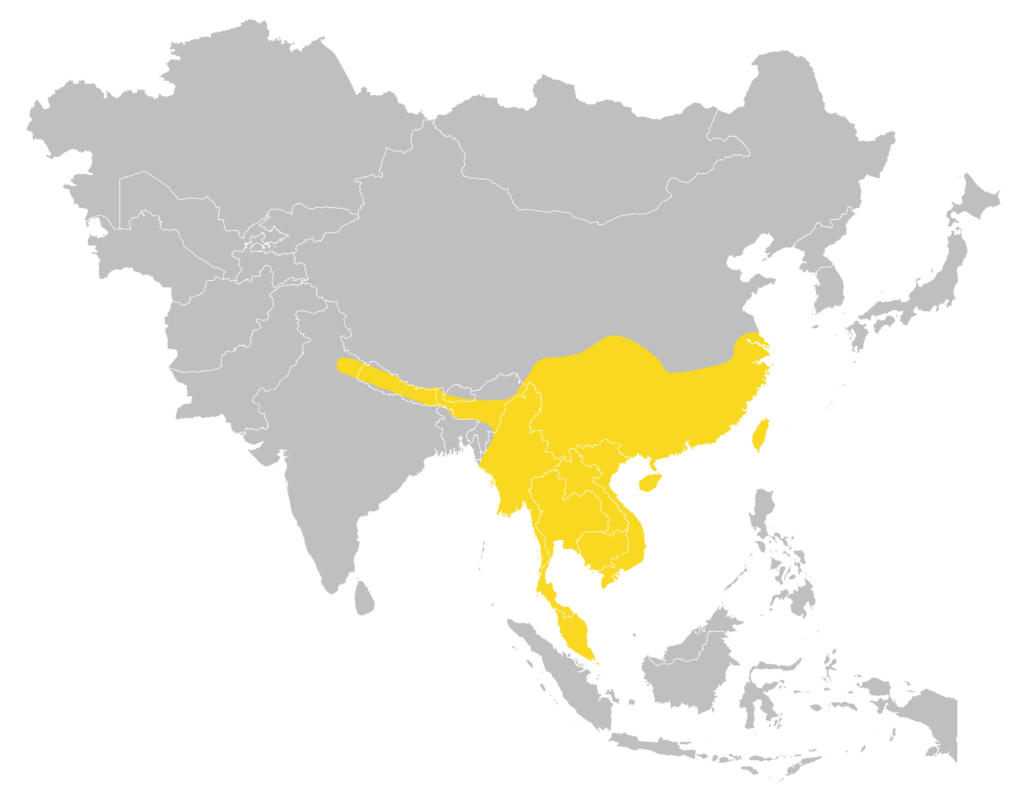
全球分布地圖 (Monadjem et al., 2019)
本地狀況及載列名錄
| 首次紀錄: | 1956年 |
| 物種來源: | 原生 |
| 本地現況: | 十分常見 (Shek & Chan, 2005) |
| 國內現況: | 無危 (中國脊椎動物紅色名錄) |
| 全球現況: | 無危 (IUCN紅色名錄) |
| 潛在威脅: | 待續 |
回聲定位

如有需要,請先註冊會員,並以電郵方式聯絡小蝙申請閱讀權限。
| Parameter | Value |
|---|---|
| Call structure | CF-FM |
| Duration | 11.90 ms |
| Inter pulse interval | 44.30 ms |
| Peak frequency | - |
| Highest frequency | 70.10 kHz |
| Lowest frequency | 56.90 kHz |
| 錄音地區: | 香港 |
| 錄音方式: | 人手放飛/野生叫聲 |
| 參考資料: | Shek & Lau, 2006 |
| Parameter | Value |
|---|---|
| Call structure | CF-FM |
| Duration | 11.10 ± 2.20 ms |
| Inter pulse interval | 45.70 ± 15.30 ms |
| Peak frequency | 65.00 ± 1.10 kHz |
| Initial frequency | 64.60 ± 1.20 kHz |
| End frequency | 55.70 ± 1.80 kHz |
| 錄音地區: | 越南 |
| 錄音方式: | 人手放飛/錄音棚 |
| 參考資料: | Furey et al., 2009 |
| Parameter | Value |
|---|---|
| Call structure | CF-FM |
| Duration | 11.20 ± 2.00 ms |
| Inter pulse interval | 32.60 ± 24.50 ms |
| Peak frequency | 68.60 ± 0.70 kHz |
| Start frequency | - |
| End frequency | - |
| 錄音地區: | 中國(桂林) |
| 錄音方式: | 錄音棚 |
| 參考資料: | Wei et al., 2011 |
參考資料
Ades, G. W. J. (1994). A comparative ecological study of insectivorous bats (Hipposideridae, Vespertilionidae and Rhinolophidae) in Hong Kong, with special reference to dietary seasonality. [Doctoral dissertation, The University of Hong Kong].
Bu, Y., Wang, M., Zhang, C., Zhang, H., Zhao, L., Zhou, H., Yu, Y., & Niu, H. (2015). Study of roost selection and habits of a bat, Hipposideros armiger in mainland China. Pakistan Journal of Zoology, 47(1), 59-69.
Cheng, H. C., & Lee, L. L. (2004). Temporal Variations in the Size and Composition of Formosan Leaf-nosed Bat (Hipposideros terasensis) Colonies in Central Taiwan. Zoological Studies, 43(4), 787-794.
Chen, C. H. (1998). Reproductive ecology of Taiwan leaf-nosed bat (Hipposideros terasensis) in Chungliao area, Nantou County. [Master’s Thesis. Tunghai University].
Chen, X. F. (1995). Activity patterns and food habits of sympatric formosan leaf-nosed bat (Hipposideros armiger) and formosan horseshoe bat (rhinolophus monoceros) in Yangmingshan area. [Master’s thesis, National Taiwan University].
Furey, N. M., Mackie, I. J., & Racey, P. A. (2009). The role of ultrasonic bat detectors in improving inventory and monitoring surveys in Vietnamese karst bat assemblages. Current Zoology, 55(5), 327-341.
Furey, N. M., & Racey, P. A. (2016). Can wing morphology inform conservation priorities for Southeast Asian cave bats?. Biotropica, 48(4), 545-556.
Han, B. Y., & He, H. Z. (2012). Study on the Food Composition of Great Leaf-nosed Bats (Hipposideros armiger) and Its Impact on the Occurrence of Forest Pests. Journal of Anhui Agricultural Science, 40(26): 12884-12885.
Ho, Y. Y., & Lee, L. L. (2003). Roost selection by Formosan leaf-nosed bats (Hipposideros armiger terasensis). Zoological Science, 20(8), 1017-1024.
Hughes, A. C., Satasook, C., Bates, P. J. J., Soisook, P., Sritongchuay, T., Jones, G., & Bumrungsri, S. (2011). Using Echolocation Calls to Identify Thai Bat Species: Vespertilionidae, Emballonuridae, Nycteridae and Megadermatidae. Acta Chiropterologica, 13(2), 447-455.
Jiang, Z. G., Jiang, J. P., Wang, Y. Z., Zhang, E., Zhang, Y. Y., Li, L. L., Xie, F., Cai, B., Cao, L., Zheng, G. M., Dong, L., Zhang, Z. W., Ding, P., Luo, Z. H., Ding, C. Q., Ma, Z. J., Tang, S. H., Cao, W. X., Li, C. W., Hu, H. J., Ma, Y., Wu, Y., Wang, Y. X., Zhou, K. Y., Liu, S. Y., Chen, Y. Y., Li, J. T., Feng, Z. J., Wang, Y., Wang, B., Li, C., Song, X. L., Cai, L., Zang, C. X., Zeng, Y., Meng, Z. B., Fang, H. X., & Ping, X. G. (2016). Red List of China’s Vertebrates. Biodiversity Science 24(5), 500‑551.
Monadjem, A., Soisook, P., Thong, V. D., & Kingston, T.
(2019). Hipposideridae. In Mittermeier, R. A., & Wilson, D. E. (Eds.), Handbook of the Mammals of the World – Volume 9 Bats (pp. 227-258). Lynx Edicions.
Shek, C. T. (2006). A Field Guide to the Terrestrial Mammals of Hong Kong. Friends of country park and cosmos book limited.
Shek, C. T., & Chan, C. S. M. (2005). Roost Censuses of Cave Dwelling Bats of Hong Kong. Hong Kong Biodiversity, 10, 1-8.
Stanton, D. J. (2017). Emergence times and seasonality of the great leaf-nosed bat (Hipposideros armiger, Chiroptera: Hipposideridae) in Hong Kong, China. Acta Theriologica Sinica, 37(3), 251.
Tong, C. P. (2016). Distribution and preference of landscape features and foraging sites of insectivorous bats in Hong Kong urban parks. [Master’s dissertation, The University of Hong Kong].
Tsui, W.C. & Chan, W. H. (2023). A Short Note on an Interesting Sighting of Himalayan Leaf-nosed Bat (Hipposideros armiger). Hong Kong Biodiversity, 27, 35-36.
Wei, L., Gan, Y. M., Li, Z. Q., Lin, Z. H., Hong, T. Y., & Zhang, L. B. (2011). Comparisons of echolocation calls and wing morphology among six sympatric bat species. Acta Theriologica Sinica, 31(2), 155-163.
Yang, Y. J. (2011). Mating system and kinship of the formasan leaf-nosed bat. Hipposideros armiger Terasensis (Chiroptera, Hippsideridae). [Marster’s dissertation, National Chung Hsing University].
Zhang, L., Jones, G., Zhang, J., Zhu, G., Parsons, S., Rossiter, S. J., & Zhang, S. (2009). Recent surveys of bats (Mammalia: Chiroptera) from China. I. Rhinolophidae and Hipposideridae. Acta Chiropterologica, 11(1), 71-88.
Hong Kong Bat Radar. (01/05/2024). A Field Guide to Bats of Hong Kong: Himalayan Leaf-nosed Bat (Hipposideros armiger ). https://hkbatradar.com/en/hipposideros_armiger
